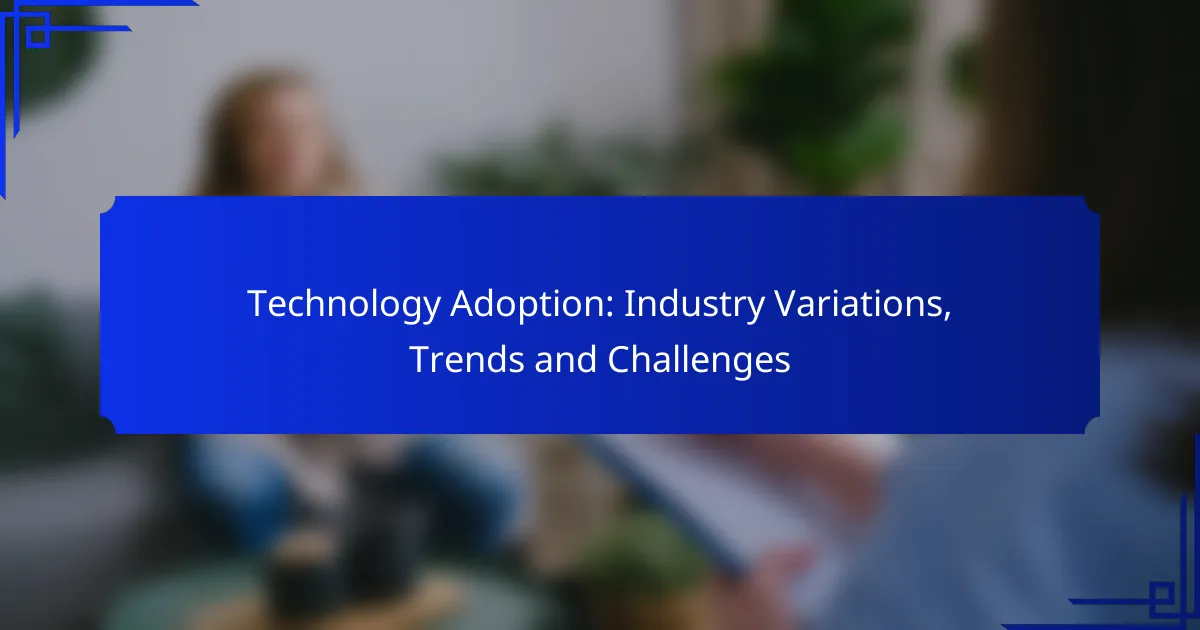Technology adoption varies significantly across industries, driven by unique trends and challenges. In healthcare, advancements like telemedicine and AI diagnostics are reshaping patient care, while manufacturing embraces smart technologies to boost efficiency. However, businesses often face hurdles such as resistance to change and skill gaps, which can impede successful implementation and overall competitiveness.
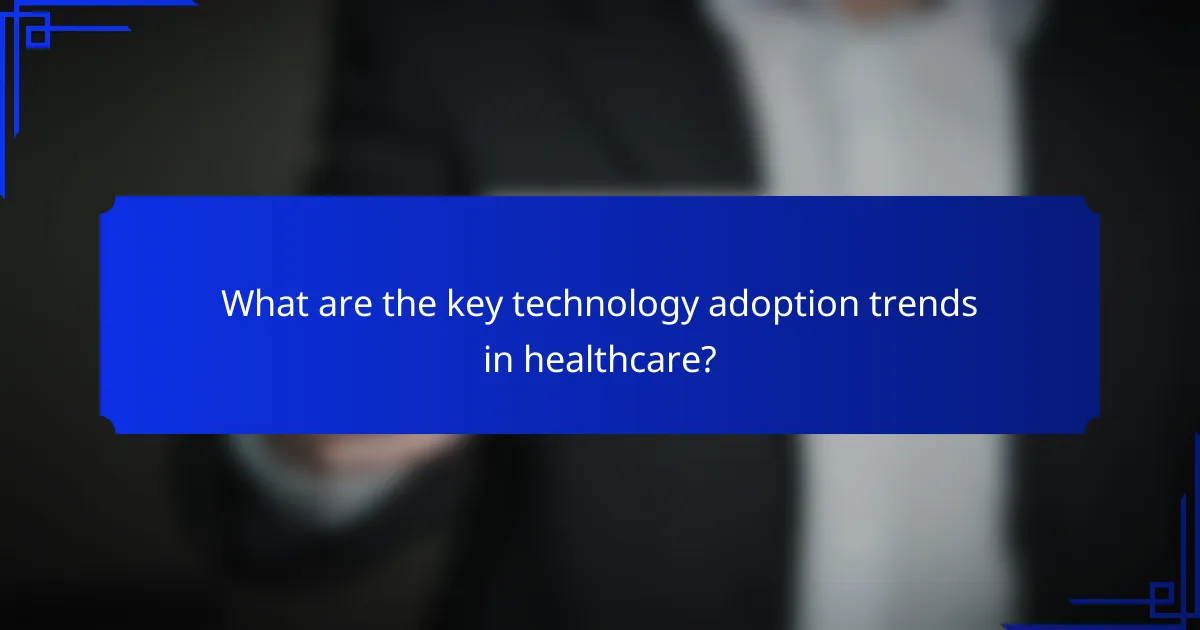
What are the key technology adoption trends in healthcare?
Key technology adoption trends in healthcare include the rapid expansion of telemedicine, the integration of artificial intelligence for diagnostics, and the increasing use of wearable health technology. These trends are transforming patient care, improving access to services, and enhancing the overall efficiency of healthcare systems.
Telemedicine growth
Telemedicine has seen significant growth, particularly accelerated by the COVID-19 pandemic. This trend allows patients to consult healthcare professionals remotely, reducing the need for in-person visits and improving access for those in rural or underserved areas.
Healthcare providers should consider investing in secure telehealth platforms that comply with regulations like HIPAA in the U.S. or GDPR in Europe. Offering a variety of communication methods, such as video calls and messaging, can enhance patient engagement and satisfaction.
AI integration for diagnostics
Artificial intelligence is increasingly being integrated into diagnostic processes, enabling faster and more accurate identification of conditions. AI algorithms can analyze medical images, lab results, and patient data to assist healthcare professionals in making informed decisions.
Healthcare facilities should evaluate AI tools based on their accuracy, ease of integration with existing systems, and compliance with medical standards. Training staff to effectively use AI technologies is crucial to maximize their benefits and minimize potential errors.
Wearable health technology
Wearable health technology, such as fitness trackers and smartwatches, is gaining popularity for monitoring health metrics like heart rate, activity levels, and sleep patterns. These devices empower patients to take an active role in managing their health and can provide valuable data to healthcare providers.
When adopting wearable technology, healthcare organizations should consider compatibility with existing health records and data privacy regulations. Encouraging patients to share their data with providers can lead to more personalized care and better health outcomes.
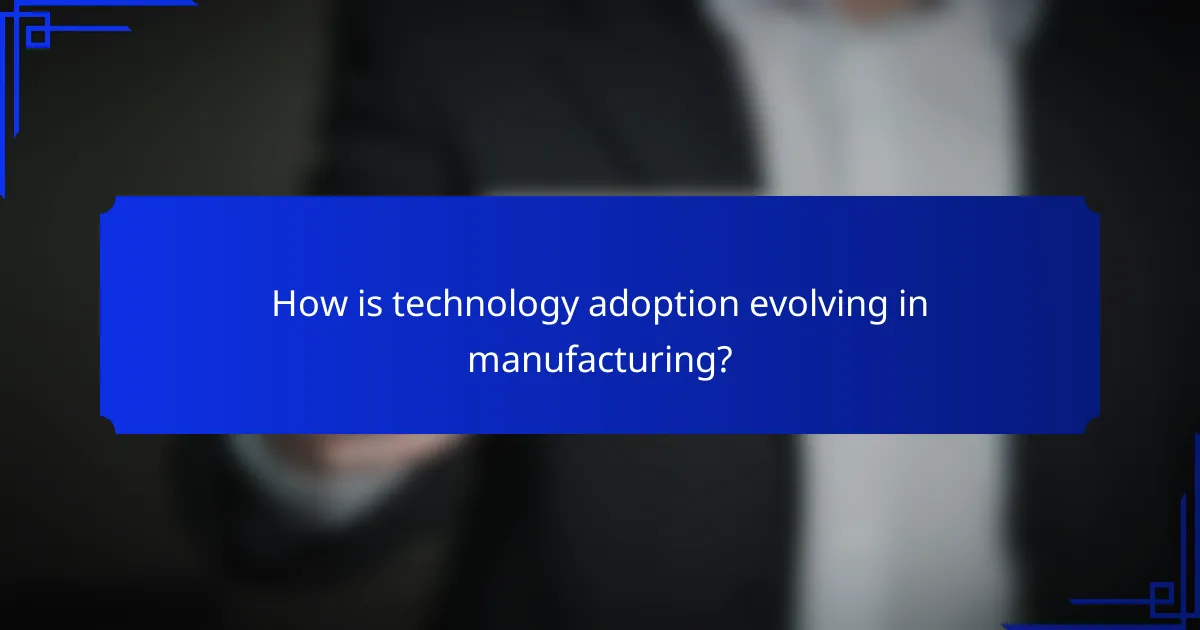
How is technology adoption evolving in manufacturing?
Technology adoption in manufacturing is increasingly focused on integrating advanced systems to enhance efficiency and productivity. Key trends include the shift towards smart manufacturing, which leverages data analytics, IoT, and automation to optimize operations.
Industry 4.0 implementation
Industry 4.0 refers to the current trend of automation and data exchange in manufacturing technologies. This includes cyber-physical systems, the Internet of Things (IoT), and cloud computing, which work together to create smart factories. Manufacturers adopting Industry 4.0 can expect improved operational efficiency and reduced downtime.
To implement Industry 4.0, companies should start by assessing their current technology landscape and identifying areas for improvement. Key steps include investing in IoT devices, upgrading legacy systems, and ensuring robust cybersecurity measures are in place. Collaboration with technology partners can also facilitate smoother transitions.
Robotics and automation
Robotics and automation are critical components of modern manufacturing, enabling companies to streamline processes and reduce labor costs. Automated systems can perform repetitive tasks with high precision and speed, leading to increased productivity and consistency in production quality.
When considering robotics, manufacturers should evaluate the specific tasks that can be automated and the potential return on investment. Common applications include assembly lines, material handling, and quality inspection. It’s essential to balance automation with workforce training to ensure employees can work alongside new technologies effectively.

What challenges do businesses face in technology adoption?
Businesses encounter several challenges in technology adoption, including resistance to change, high implementation costs, and skill gaps in the workforce. These obstacles can hinder the effective integration of new technologies, impacting overall productivity and competitiveness.
Resistance to change
Resistance to change is a common challenge that businesses face when adopting new technologies. Employees may feel threatened by new systems or processes, leading to reluctance in embracing them. This resistance can stem from fear of job loss, lack of understanding, or comfort with existing workflows.
To mitigate resistance, companies should communicate the benefits of the new technology clearly and involve employees in the transition process. Providing training and support can help ease concerns and foster a more positive attitude towards change.
High implementation costs
High implementation costs can be a significant barrier to technology adoption for many businesses. Expenses may include purchasing new hardware, software licenses, and ongoing maintenance, which can strain budgets, especially for small to medium-sized enterprises.
To manage these costs, businesses should conduct a thorough cost-benefit analysis before proceeding with technology investments. Exploring options such as cloud-based solutions or phased rollouts can help spread expenses over time and reduce upfront financial burdens.
Skill gaps in workforce
Skill gaps in the workforce present another challenge in technology adoption. Many employees may lack the necessary skills to effectively use new technologies, leading to decreased productivity and potential errors. This issue is particularly prevalent in industries that rapidly evolve, such as IT and manufacturing.
To address skill gaps, businesses should invest in training programs that focus on upskilling employees. Collaborating with educational institutions or offering online courses can provide workers with the tools they need to succeed in a technology-driven environment.
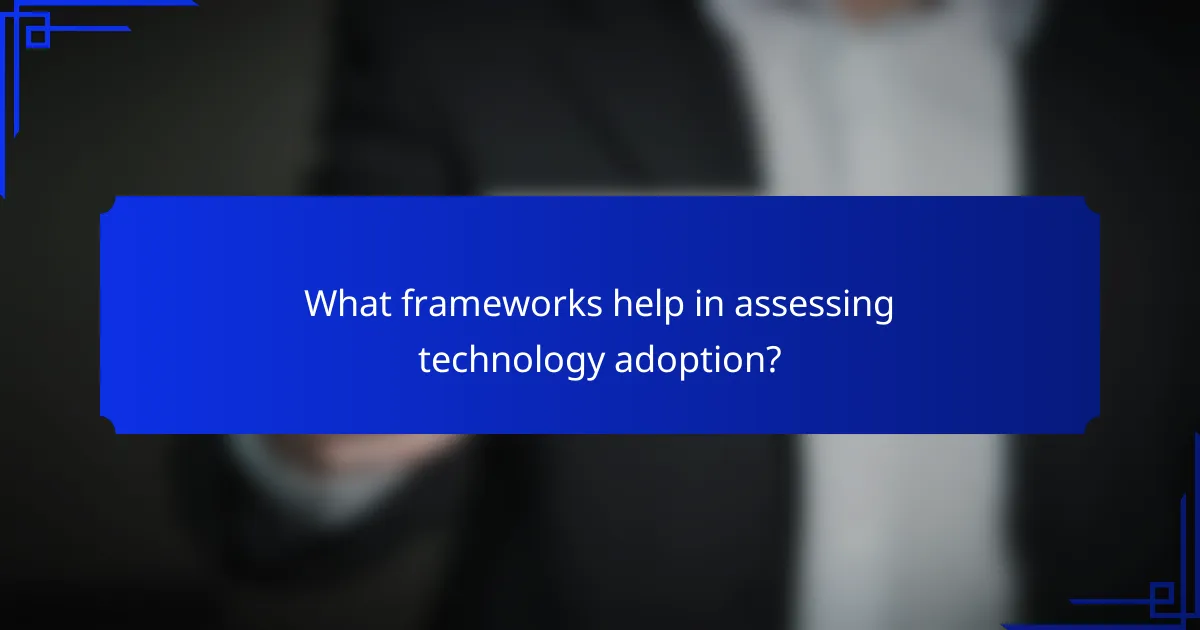
What frameworks help in assessing technology adoption?
Frameworks for assessing technology adoption provide structured approaches to evaluate an organization’s readiness and capacity for implementing new technologies. These frameworks help identify gaps, strengths, and areas for improvement, enabling informed decision-making and strategic planning.
Technology readiness assessment
A technology readiness assessment (TRA) evaluates an organization’s preparedness to adopt new technologies. It typically involves analyzing factors such as infrastructure, skills, and organizational culture. Organizations can use surveys and interviews to gather data on employee attitudes and capabilities regarding technology.
Key components of a TRA include assessing existing technology, identifying training needs, and evaluating the alignment of technology with business goals. For instance, a company may find that while its infrastructure is robust, its workforce lacks the necessary digital skills, indicating a need for targeted training programs.
Digital maturity models
Digital maturity models provide a framework to gauge an organization’s current state of digital transformation and its readiness for further technology adoption. These models often categorize maturity into stages, such as initial, developing, established, and advanced, allowing organizations to benchmark their progress against industry standards.
When using a digital maturity model, organizations should consider factors like leadership support, technology integration, and customer engagement. For example, a company at the developing stage may have implemented basic digital tools but lacks comprehensive data analytics capabilities, highlighting areas for growth. Regular assessments against the model can guide strategic investments and initiatives to enhance digital maturity.
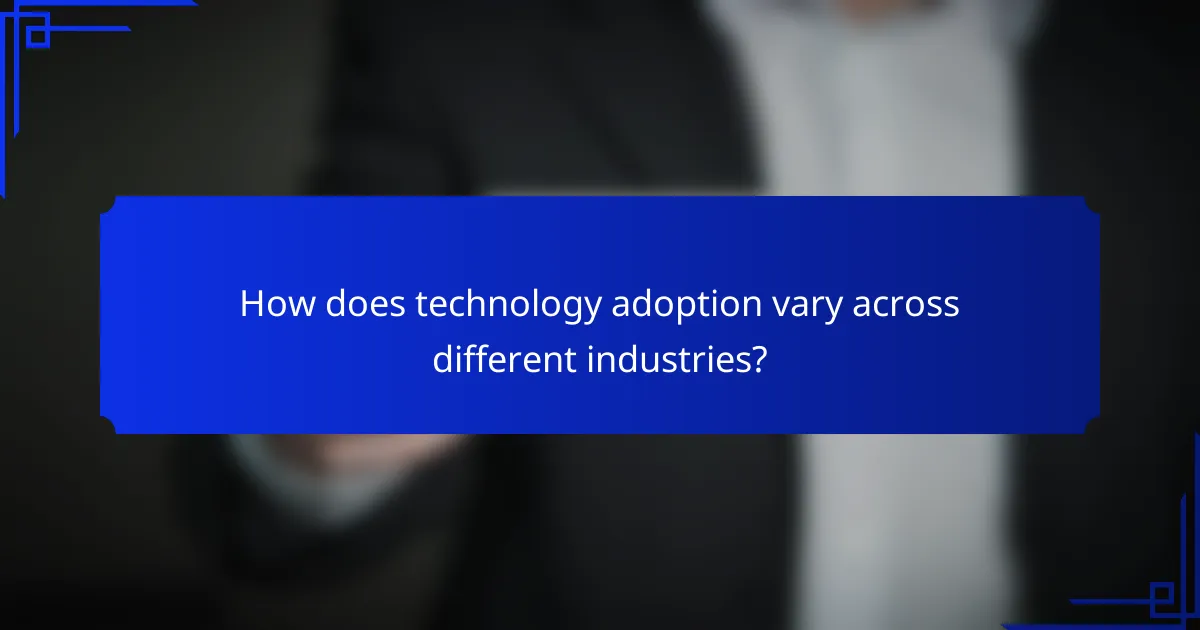
How does technology adoption vary across different industries?
Technology adoption varies significantly across industries due to factors such as regulatory environments, customer expectations, and operational needs. Industries like retail and financial services often lead in adopting innovative technologies, while others may lag due to complexity or cost concerns.
Retail technology innovations
Retailers are increasingly leveraging technology to enhance customer experiences and streamline operations. Innovations such as mobile payment systems, augmented reality for virtual try-ons, and inventory management software are transforming how retailers engage with consumers.
For example, many stores now use point-of-sale systems that integrate with e-commerce platforms, allowing for seamless transactions both online and in-store. Retailers should consider investing in technologies that provide real-time data analytics to better understand consumer behavior and optimize inventory levels.
Financial services digital transformation
The financial services sector is undergoing a significant digital transformation, driven by the need for efficiency and improved customer service. Technologies such as blockchain, artificial intelligence, and mobile banking applications are reshaping how financial institutions operate and interact with clients.
For instance, banks are adopting AI-driven chatbots to handle customer inquiries, reducing wait times and improving service quality. Financial institutions must prioritize cybersecurity measures as they adopt new technologies, ensuring compliance with regulations such as GDPR in Europe or PCI DSS for payment data security.
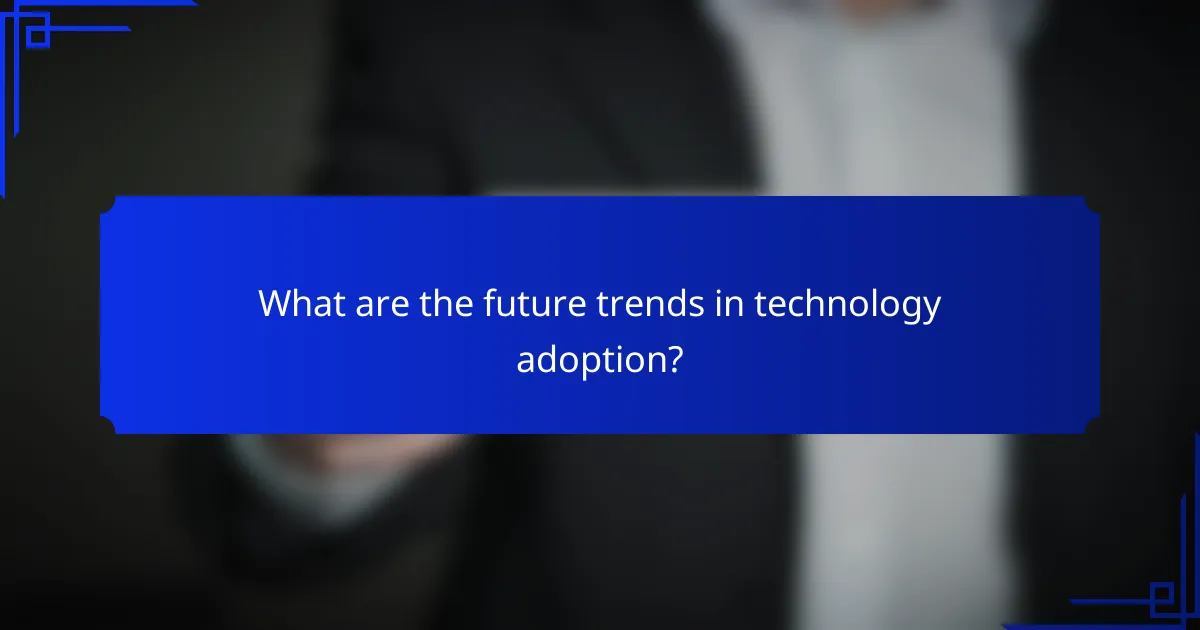
What are the future trends in technology adoption?
Future trends in technology adoption are increasingly shaped by the need for enhanced security, greater connectivity, and the integration of advanced technologies across various sectors. Organizations are focusing on adapting to these trends to remain competitive and secure in a rapidly evolving digital landscape.
Increased focus on cybersecurity
As cyber threats become more sophisticated, organizations are prioritizing cybersecurity in their technology adoption strategies. This includes investing in advanced security measures such as multi-factor authentication, encryption, and regular security audits to protect sensitive data.
Companies are also adopting frameworks like the NIST Cybersecurity Framework to guide their security practices. This proactive approach helps mitigate risks and ensures compliance with regulations such as GDPR or CCPA, which mandate strict data protection measures.
Expansion of IoT applications
The Internet of Things (IoT) is expanding rapidly, with applications ranging from smart home devices to industrial automation. Businesses are leveraging IoT to enhance operational efficiency, reduce costs, and improve customer experiences through real-time data collection and analysis.
For example, manufacturers are using IoT sensors to monitor equipment health, enabling predictive maintenance that can save significant downtime costs. As IoT technology becomes more affordable and accessible, its adoption is expected to grow across various industries, including healthcare, agriculture, and transportation.
